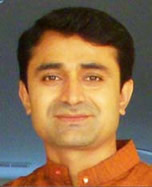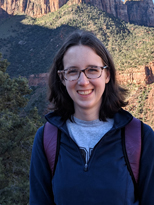Faculty
Director and Professor
Microbiology and Immunology
David H Smith Center for Vaccine Biology and Immunology
Antigenic evolution and immunity to influenza
Why does the influenza vaccine fail? In spite of substantial efforts to vaccinate, influenza epidemics remain a major public health threat. In the US, the currently licensed vaccines are very safe, but only partially effective at protecting from infection. Though efficacy rates vary with age of the subjects and virus strains, estimates of protection range from 10-70%. As our abilities to study influenza viruses at the molecular level increase, and the costs to do so decrease, there are more reports of a significant degree of sequence diversity in the viruses that circulate seasonally. This raises the possibility that some of the vaccine failures may be due to antigenic drift in the viruses. Unfortunately, there are few (to no) studies that have assayed the virus sequences and antigenicity, and the specificity or function of the antibodies and memory B cells present in the subject who is infected.
As part of our surveillance activities, we will collect and analyze the viruses causing infections and match these to the individual’s antibody and B cell responses present before infection or at the time illness begins. We will also study the impact of infections versus vaccination on the responding B cell and immunoglobulin (Ig) specificity and function, including development of memory. We will also use in vitro approaches that drive antigenic drift in prototypical seasonal influenza viruses to better understand how differences in immune profiles affect virus evolution. To take this further, we propose to use the information from circulating viruses and antibody/B cell specificity to develop computational tools that analyze and predict human immune responses to influenza. We will use these models to both better understand human immunity to flu, but to also simulate how prior immunity affects immune responses to various immunization strategies.
Our goal is to develop approaches to immunization that produce more broadly cross-reactive and even “universal” immunity to flu. To accomplish these lofty goals, we have assembled a team of the very best immunologists, virologists, computational biologists, and clinical investigators who will work together on this project using cutting edge technologies. These studies have the potential to change the way we think about influenza immunity and vaccination, and create a better understanding of immune protection and virus selection.
Assistant Professor
Department of Medicine
Dr. Branche is an assistant professor at the University of Rochester, School of Medicine. She currently has a clinical inpatient practice comprised of both general infectious diseases and HIV medicine patients. Dr. Branche is also a New York State designated HIV/AIDS provider and has a practice comprised of adult patients ages 18 and older at the URMC HIV Clinic.
The focus of her research has been clinical and translation research in the field of respiratory infections in adults. Dr. Branche received her Bachelor of Arts degree in Biology at the University of Pennsylvania and Doctorate in Medicine at American University of the Caribbean. She completed residency in Internal Medicine at NYU Lutheran in Brooklyn, NY and infectious disease fellowship at the University of Rochester. During her training years at the University of Rochester her focus in research involved the use of viral diagnostics and serum biomarkers to investigate acute viral respiratory illnesses in adults. She is currently a clinical investigator in the National Institute of Allergy and Infectious Diseases Respiratory Pathogen Research Center at the University of Rochester and her current research activities have been expanded to include surveillance studies for bacterial pathogens including the presence of nasopharygneal colonization with Streptococcus pneumoniae in older and the clinical and biological impact of colonization in this population. She has experience in the development and performance of diagnostic PCR assays for respiratory viruses including influenza, respiratory syncytial virus, coronaviruses and human metapneumovirus as well as bacterial pathogens such as Streptococcus pneumoniae. Dr. Branche has published several peer-reviewed articles, reviews and book chapters related to respiratory viral pathogens in adults.
Senior Associate
Department of Biostatistics and Computational Biology
Ms. Holden-Wiltse received her MPH from University of Michigan School of Public Health in 1991, and has over 17 years of experience in biostatistical support having held positions in industry, government, not-for-profit organizations and academia. Ms. Holden-Wiltse will act as Co-Leader of the Data Management, Bioinformatics and Biostatistics Core.
Associate Professor
Texas Biomedical Research Institute
Dr. Martínez-Sobrido received his Ph.D. in Virology and Molecular Biology in 2000 from the Instituto de Salud Carlos III and completed Postdoctoral training at Mount Sinai School of Medicine. He is currently Assistant Professor. He is interested in the use of plasmid-based reverse genetics techniques to rescue recombinant influenza viruses. He will construct recombinant single cycle influenza viruses for assessment of immunity.
Professor
Microbiology and Immunology
David H Smith Center for Vaccine Biology and Immunology
Immunodominance of CD4 T cell responses to influenza virus
Dr. Sant received her Ph.D. in Immunogenetics from Washington University in St. Louis in 1985. She currently Professor of Microbiology and Immunology at the University of Rochester. The research in Dr. Sant’s laboratory centers around the molecular events that regulate MHC class II- restricted antigen presentation of influenza proteins by antigen presenting cells (APC) and CD4 T cell recruitment in vivo. Dr. Sant will lead project 3, focused on the CD4 response to infection and vaccination, and the potential impact of CD4 peptide specificity on the development of B cell responses specifically to the HA protein.
Dr. Wilson received his Ph.D. in Immunology from the University of Texas Southwestern Medical Center in 2000, and post- doctoral training in the Nussenzweig lab at The Rockefeller University in New York City. He currently serves as Associate Professor with tenure in the Department of Medicine/Rheumatology,at the University of Chicago.
Dr. Wilson’s interests include the development of technology to clone recombinant monoclonal antibodies from discreet populations of B cells. Dr. Wilson will lead Project 2 focused on the B cell response to infection, as well as providing monoclonal antibodies he has, and cloning additional human antibodies specific for influenza HA and NA glycoproteins.
Affiliate Associate Professor
Department of Microbiology
Assistant Member
Fred Hutchinson Cancer Research Center
The Bloom Lab’s research focuses on various aspects of the molecular evolution of proteins and viruses, particularly influenza. He is looking at the mechanisms that allow the flu to evolve its genes. So far, he has discovered that one of the flu genes built up a series of mutations in a particular order, and this is the only order in which the intermediate viruses were able to reproduce.
Assistant Professor in Ecology & Evolution and the Committee on Microbiology
University of Chicago
Dr. Cobey computationally models the evolution of influenza and the evolution of antibody repertoires. She uses diverse approaches that range from phylogenetics and population genetics to longitudinal and population-level dynamical models. She is working with Scott Hensley to use cross-sectional data on antibody repertoires to improve forecasting of influenza for vaccine strain selection. Her other work investigates immunodominance and original antigenic sin. Dr. Cobey received a PhD in Ecology & Evolution from the University of Michigan in 2009 and completed a postdoctoral fellowship at the Harvard School of Public Health.
Stockholm University
The maturation and assembly of viral membrane glycoproteins
Millions of people died world-wide as a result of the type A influenza pandemics of 1918 (H1N1), 1957 (H2N2) and 1968 (H3N2). The large number of avian influenza subtypes and the ability of influenza to undergo genetic reassortment and rapidly evolve raise the possibility that other pandemic strains can develop such as the pandemic H1N1 strain of swine origin in 2009 and the H7N9 strain in 2013. Currently, we cannot predict if all of the hemagglutinin (H) and neuraminidase (N) subtypes are capable of surfacing in the human population, but several factors (e.g. cell surface receptors, optimal replication temperatures, and mutations in the viral RNA polymerase) are known to act as barriers to genetic reassortment between human and avian influenza. Our lab is focused on investigating how the different subtypes of the influenza surface antigen neuraminidase assemble, mature and function under varying cellular and environmental conditions. This knowledge is then applied to the ever expanding influenza database to identify conserved and variable regions within and across subtypes to pinpoint features that are evolving or must evolve to cross the species barrier. Through cellular and biochemical analysis of how these alterations change neuraminidase and viral assembly and impact viral propagation, we can begin to illustrate a picture of the potential threats each subtype poses for genetic reassortment and the magnitude of the complimentary changes that are necessary for them to successfully enter the human population.
Dr. Golding will assist with studies conducted under project 1. Dr. Golding received her Ph.D. in Immunology from Oregon Health Sciences University in 1981, and completed post-graduate work as a Visiting Fellow under Dr. Alfred Singer in 1985 at the Immunology Branch, NCI, NIH, and then as a Visiting Associate in the same branch under Dr. Dinah Singer in 1987. She joined the Food and Drug Administration in 1989, and since 1993 she has served as Chief of the Laboratory of Retrovirus Research in the Division of Viral Products, Center for Biologics Evaluation and Research (CBER), Food and Drug Administration (FDA). She will lead the experiments in Aims 1 and 2 of Project 1 to perform Gene Fragment Phage Display Library (GFPDL) studies of antibody specificity, a technique that she pioneered for use in influenza.
Assistant Professor
Duke University
Our lab is interested in the genetic engineering of negative sense RNA viruses, particularly respiratory viruses such as influenza viruses. These manipulated viruses, together with transgenic animal models, allow us to ask novel questions about the biology of viral infections. We have established systems that allow for the tagging of viral proteins as well as the insertion of entire genes with minimal costs to the virulence of the virus. These platforms allow us to generate novel viral tools for probing specific aspects of viral infections not previously possible.
We are currently interested in the use of influenza viruses that express various reporter proteins that allow us to to:
- Study viral tropisms and cell fate following infection
- Understand how infections influence immunity to secondary infections
- Evaluate vaccination strategies and antiviral therapeutic efficacies in vivo
Additionally, we are interested in engineering these viruses for various biotechnology applications such as vaccine delivery systems.
Our over-arching goal is to further our basic understanding of how cells are altered by viral infection, and how that alteration affects lung disease in the short and long term. Our increased understanding of these mechanisms will allow us to apply this knowledge to develop new, or improve existing, treatments for respiratory virus disease.
The University of Chicago
Carole obtained her PhD in France in 2010 and did her postdoctoral training at the University of Chicago. She is currently a staff scientist in the laboratory of Dr. Patrick Wilson. She is interested in B cell responses to influenza and focuses mainly on vaccine-induced antibody responses. She will assist Dr. Wilson with project 2 as well as lead her own project on human antibody responses to influenza B viruses.
Associate Professor
University of Pennsylvania
He received his B.A. in Biology from the University of Delaware in 2000 and his Ph.D. in Cell and Molecular Biology from the University of Pennsylvania in 2006. He completed a postdoctoral fellowship at the National Institute of Health from 2007-2010 and was an Assistant Professor at the Wistar Institute from 2010-2016. The Hensley laboratory studies mechanisms that promote antigenic drift of influenza viruses and factors that influence influenza vaccine responsiveness.
Dr. Surender Khurana will assist in the conduct of studies in project 1. Dr. Khurana received his Ph.D. in Biochemistry in 2002 from Delhi University, India. He has been at the Food and Drug Administration since 2002, where he currently serves as Staff Scientist in the Division of Viral Products, Center for Biologics Evaluation and Research (CBEM). His research interests are focused on developing new molecular tools for better understanding of how different vaccine modalities and novel adjuvants improve protective immunity against influenza. Dr. Khurana developed the Surface Plasmon Resonance (SPR) assays which will be used in project 1.
Associate Professor
University of Alabama Birmingham
The Kobie Laboratory is focused on translational B cell immunology. Through the development of high throughput and high resolution technologies the lab dissects the mechanisms of protective and pathogenic B cell and antibody responses to advance vaccine development and disease therapeutics
Professor
Icahn School of Medicine at Mount Sinai
Currently Dr. Krammer holds a position as a Professor at the Department of Microbiology at the Icahn School of Medicine at Mount Sinai. He has published more than 100 papers, is member of the editorial boards of the Journal of Virology, Plos One and Heliyon and is a peer reviewer for more than 30 journals. Dr. Krammer is also member of the Vaccine and Edward Jenner Society Young Investigator Program. In addition he is a scientific adviser for enGenes and PathSensors.
The Krammer laboratory – which is part of the NIH-funded Centers for Excellence in Influenza Research and Surveillance (CEIRS) – focuses on understanding broadly-reactive immune responses against the surface glycoproteins of RNA viruses such as influenza with the goal to develop better vaccines and novel therapeutics.
Assistant Professor
University of Minnesota
Immunity to influenza virus infections
Influenza A virus (IAV) represents a major global health burden. Despite yearly vaccinations the virus is able to escape seasonal immunity requiring yearly vaccination and the threat of novel pandemics loom. Therefore continued understanding of the host-pathogen interactions and protective immune responses are critical for broadly protective vaccine development. Our overall research goal is to address fundamental questions in virology and viral immunology that have been difficult to dissect using conventional approaches. We utilized host-derived microRNAs, small non-coding RNA capable of mediating silencing of mRNA, to restrict the natural tropism of IAV. This allows for previously unavailable insights into immune responses to the virus. Additionally, we generate novel reporter viruses to further define the relationship between cellular tropism and immunity as well as to determine infected cell fate. A more comprehensive understanding of virus infection requirements that dictate immunity will be critical for the design of next generation vaccines and therapeutics.
Arnold S. Monto, MD is the Thomas Francis Jr. Collegiate Professor of Public Health at the Department of Epidemiology, University of Michigan School of Public Health. Respiratory infections in tropical and temperate regions have been a major interest. He led the studies of respiratory illnesses in Tecumseh, MI, a landmark investigation of infection in the community Dr. Monto had been involved in assessing the efficacy of various influenza vaccines and of neuraminidase inhibitors and other compounds in prophylaxis and therapy of influenza. He now heads observational studies of effectiveness of influenza vaccines and household studies of respiratory viral infections, including respiratory syncytial virus (RSV). He has been a member of the National Allergy and Infectious Disease Advisory Council of the US National Institutes of Health and is now a member of the FDA’s Vaccines and Related Biologicals Advisory Committee (VRBPAC). He is a past president of the American Epidemiological Society, the 2009 recipient of the Alexander Fleming Award of the Infectious Diseases Society of America for lifetime achievement and the 2012 recipient of the Charles Merieux award of the National Foundation for Infectious Diseases.
Associate Research Scientist
Columbia University
In my current position as a faculty member in the Center for Infection and Immunity (CII) at Columbia University, I lead collaborative influenza research projects under a NIH subcontract while conducting systems-level research pertaining to emerging and re-emerging pathogens. My specialty is combining computational analysis, immunological and virological methods to address questions at the host-pathogen interface. I have spent the last 14 years studying innate immune responses to viral pathogens such as dengue virus, rhinovirus, poliovirus, yellow fever virus and influenza virus. During my graduate studies at Columbia University, I discovered that a viral protease facilitated poliovirus and rhinovirus interferon resistance. During my postdoctoral training at Mount Sinai School of Medicine, I discovered and characterized two novel and disparate mechanisms whereby the NS5 proteins of dengue virus and yellow fever virus inhibit interferon signaling to enhance viral replication and pathogenesis. These discoveries earned my research a PLOS Pathogens cover, an editorial in Cell Host & Microbe, and a vaccine patent. At the University of Washington, I showed that influenza disease severity correlates with host transcriptional signatures of increased cytokine production, decreased coagulation signaling, and decreased lipid metabolism. This research was featured in Microsoft’s #DoMore campaign (June 2015) and in American Society for Microbiology’s Microbe Magazine (August 2014).
My current focus is computationally identifying and experimentally validating immune cell populations and host pathways and that can be targeted therapeutically to ameliorate severe viral disease. A major interest of mine is using tissue deconvolution algorithms and immunological tools to study the dynamics of lung immune cell populations during influenza virus infections, and spleen and liver immune cell populations during dengue virus infections. My goal is to translate these findings into host-targeted influenza and flavivirus therapeutics.
Associate Professor
Department of Pediatrics
Associate Professor
Department of Microbiology and Immunology
Dr. Nayak received her M.D. from the State University of New York at Buffalo in 2004 and subsequently completed residency training in Pediatrics and a fellowship in Pediatric Infectious Diseases at the University of Rochester. She is currently an Assistant Professor in the Department of Pediatrics. The research in Dr. Nayak’s laboratory is focused on understanding how a child’s early exposure to influenza shapes immunity and poises the immune system to respond to subsequent influenza challenge. While some children continue to have their first exposure to influenza through infection, high influenza morbidity in infants and children has led to a universal recommendation for inactivated influenza vaccination starting at 6 months of age, with children >24 months able to receive live attenuated vaccine. Despite this, little is known about how these different modes of priming alter the development of influenza-specific immunologic memory. To better understand these issues, Dr. Nayak is conducting a clinical study to determine how the functional potential of the anti-influenza immune response in early childhood is initially shaped by infection versus vaccination and the consequences this has on the subsequent development of long term anti-influenza immunity.
Research Investigator
University of Michigan
Joshua G. Petrie is a Research Investigator in the Department of Epidemiology at the University of Michigan School of Public Health. He received his BS (2004) in Biology from the University of Michigan, and his MPH (2008) and PhD (2016) in Epidemiology from the University of Michigan School of Public Health. Dr. Petrie’s research interests include the epidemiology and transmission of respiratory viruses, influenza vaccine effectiveness, and serologic correlates of protection.
Biomedical Scientist
Lawrence Livermore National Laboratory
Dr. Rasley is a biomedical scientist working in the host-pathogen biology group within the Biosciences and Biotechnology Division. Her past research efforts during her Ph.D. and Postdoctoral tenures focused on understanding the initiation of innate immune responses within the central nervous system during bacterial infections. Current research interests include understanding the initiation of innate immune responses to bacterial pathogens and host-pathogen interactions. Ongoing studies involve characterization of the host response to Francisella tularensis and Yersinia pestis infection using DNA microarray technology and imaging approaches as well as identifying bacterial genes important for pathogenesis and disease progression.
Research Professor
David H Smith Center for Vaccine Biology and Immunology
Dr. Sangster received his Ph.D. in Virology/Genetics from the University of Western Australia in 1991. He then completed postdoctoral work in Immunology at St. Jude’s Children’s Research Hospital. Dr. Sangster is an expert in the analysis of B cell responses to infection and vaccination. His major interests have been mucosal aspects of B cell responses in the respiratory tract and the nature of virus-specific B cell memory. He will perform studies of mucosal antibody and B cell responses, and B cell memory.
Professor
WHO Collaborating Centre for Reference and Research on Influenza at VIDRL and the Peter Doherty Institute for Infection and Immunity
Melbourne, Australia
Dr. Kanta Subbarao was appointed in 2016 as Director of the WHO Collaborating Centre for Reference and Research on Influenza at VIDRL and the Peter Doherty Institute for Infection and Immunity in Melbourne. Dr. Subbarao is a virologist and a physician with specialty training in pediatrics and pediatric infectious diseases. She received her M.B.B.S. from Christian Medical College, Vellore in India, completed training in pediatrics and pediatric infectious diseases in the US and earned an M.P.H. in epidemiology from the University of Oklahoma Health Sciences Center. She received postdoctoral training in the Laboratory of Infectious Diseases (LID), National Institute for Allergy and Infectious Diseases, National Institutes of Health (NIH).
Prior to her arrival in Melbourne, she was Chief of the Emerging Respiratory Viruses Section of LID, NIAID, NIH in Bethesda from 2002-2016 and chief of the Molecular Genetics Section of the Influenza Branch at the CDC in Atlanta from 1997-2002.
Dr. Subbarao’ s research is focused on newly emerging viral diseases of global importance including pandemic influenza, severe acute respiratory syndrome (SARS) and Middle East Respiratory Syndrome (MERS) and includes study of virus biology and pathogenesis, immune responses to infection and vaccination, development and preclinical and clinical evaluation of vaccines. Dr. Subbarao has authored more than 175 peer-reviewed publications in leading journals including Science, Nature, PNAS and the Journal of Virology, and 50 reviews or chapters, a majority on influenza and SARS. She is a Fellow of the American Academy of Microbiology and the Infectious Diseases Society of America and is a member of the American Society of Microbiology, Pediatric Infectious Diseases Society and American Society for Virology. She serves on the Editorial Board of PLoS Pathogens and mBio.
Ms. Francis received her R.N. in 1973 from the Highland Hospital School of Nursing. She currently serves as Research Administrator and Coordinator for the Vaccine Research Unit in the Infectious Diseases Division at the University of Rochester. Ms. Francis is a highly experienced clinical research coordinator, and she will oversee regulatory and operational aspects of clinical research conducted by NYICE.
David H Smith Center for Vaccine Biology and Immunology
University of Rochester
Stefanie Fingler currently serves as Research Program Manager directing and coordinating the Center for Vaccine Biology and Immunology (CVBI), as well as several large subdivisions/projects associated with the CVBI, including Administrator for the New York Influenza Center of Excellence (NYICE) at the University of Rochester.
Stefanie joined the University of Rochester in 2008 and has worked in both accounting and research administration over the last several years. In her current role, she is responsible for both pre-award and post-award management, including developing, monitoring and administering budgets for grants and contracts. She further serves as the chief financial officer of the Center overseeing all intramural funds and extramural research awards, as well as overall center administration. She has a deep knowledge of directing staff and electronic submission of proposals, contract application accounting, and good understanding of federal, state, and institutional regulations.
David H Smith Center for Vaccine Biology and Immunology
University of Rochester









